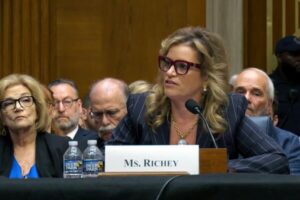
Trump Order Puts Politics Above Peer Review, Researchers Say
Since Inauguration Day, the Trump administration has repeatedly frozen and terminated research funding for seemingly political reasons. Federal agencies have ended grants for studies because they allegedly advanced diversity, equity and inclusion or “gender ideology,” and they’ve cut off research dollars across the board for some universities to pressure them to crack down on pro-Palestine advocacy and bar transgender women from women’s sports.
But, late last week, the president laid out new processes for how he wants “senior appointees” to take charge of awarding, or denying, new federal grants. He also ordered that they regularly review grants that have already been awarded—and consider terminating them.
The executive order, in one sense, puts into writing the administration’s ongoing efforts to assert greater control over who receives grants and for what kinds of research. But researchers and those who advocate for them and their institutions also say some aspects of the order escalate this campaign. Moreover, they say the political review threatens to further slow the flow of federal research funding over all.
“The [order] would add a new and unnecessary layer of bureaucracy that will diminish the role of quality and excellence in science while simultaneously adding delay to the process of evaluating and awarding grant proposals,” Barbara R. Snyder, president of the Association of American Universities, said in a statement Tuesday. She said it “will apparently replace the merit-based system of science-based decision-making for research grant funding in favor of decision-making by political appointees.”
Debbie Altenburg, vice president for research policy and advocacy at the Association of Public and Land-grant Universities, said, among the other provisions, “certainly, adding a term and condition to grants for cancellation for convenience is a significant change.”
President Trump’s executive order further prohibits federal officials from awarding discretionary grants that fund or “promote” specific purposes that conservatives have railed against: illegal immigration, racial preferences, “intentional proxies for race” and “the notion that sex is a chosen or mutable characteristic.” It criticized past federal funding of “drag shows in Ecuador,” “transgender-sexual-education programs” and critical race theory training, though the White House didn’t provide Inside Higher Ed examples of this.
But the order doesn’t just aim at specific targets of the right. It uses broad language to ban funding for initiatives that “promote anti-American values,” without defining that. It further requires discretionary grants to “where applicable, demonstrably advance the President’s policy priorities,” without defining where that’s applicable.
This misguided order will slow progress for cures and treatments that patients and families across the country urgently need by delaying critical research with problematic political and bureaucratic hurdles.”
—Association of American Medical Colleges
And it threatens grant money that’s already been awarded, by ordering the Office of Management and Budget to ensure future discretionary grants can be terminated “for convenience.” It further directs other federal agencies to revise terms for existing grants “to permit immediate termination for convenience.”
In multiple places, the order urges the senior appointees at grant-making agencies to question peer reviewers’ assessment of who deserves funding.
“Senior appointees and their designees shall not ministerially ratify or routinely defer to the recommendations of others in reviewing funding opportunity announcements or discretionary awards, but shall instead use their independent judgment,” the order says, adding later that peer-review recommendations must “remain advisory.”
‘Bottlenecks’
Backlash to the order was swift as the major research associations and some individual researchers spoke out against what they called a usurpation of merit-based review of grant applications. Ultimately, they said, the order prioritizes politics above peer review, adding that it will further slow research funding when federal grant making is already lagging.
The Association of American Medical Colleges said in a statement Friday that the order “will create significant bureaucratic bottlenecks in the grant review and approval process, slowing the pace of innovation and introducing political preferences as part of the approval process.”
“This misguided order will slow progress for cures and treatments that patients and families across the country urgently need by delaying critical research with problematic political and bureaucratic hurdles,” the association said.
Todd Wolfson, president of the American Association of University Professors, said in a statement, “This order further weakens our nation’s ability to conduct and support scientific research across various fields by replacing experts with ideologically driven political stooges who have no expertise and no business making decisions on academic research.”
Katie Lotterhos, an associate professor of marine and environmental sciences at Northeastern University, told Inside Higher Ed that “political review of grants is definitely going to narrow the kinds of science that can be done.
“Now scientists not only have to get through that whole gantlet of peer review and panel review—there’s going to be an additional gantlet of political review,” Lotterhos said.
Lotterhos also said she thinks the order “just formalizes what we think is already being done behind the scenes.”
Joanne Padrón Carney, chief government relations officer for the American Association for the Advancement of Science, told Inside Higher Ed the Trump administration already placed an “additional level of review” atop peer review in the form of the Department of Government Efficiency, which led grant-cancellation efforts.
Carney said one could argue that the executive order codifies “steps the administration has already undertaken” and could give officials some legal cover. Many of the higher ed–related lawsuits filed against the administration are challenges of grant cuts. But she said the order could also establish “a more formalized process that leaves in question how research proposals based on advancing scientific ideals will be measured against the administration’s priorities.”
Additionally, it’s “critically important to emphasize that it also codifies a layer of red tape that is a bottleneck in the execution of great science and research awards,” Carney said. She and others have raised concerns that the National Institutes of Health won’t be able to spend all its allocated grant money before the fiscal year ends next month—meaning that money will return to the U.S. Treasury.
“It slows down the research process, and it introduces more uncertainty,” Carney said.
Even for future grants that are awarded and aren’t later officially rescinded, the order may still stymie researchers’ access to funds. It says agency heads, to the extent legal and “practicable,” must put terms into grant agreements banning “recipients from directly drawing down general grant funds for specific projects without the affirmative authorization of the agency” and requiring grantees to “provide written explanations or support, with specificity, for requests for each drawdown.”
A key reason U.S. science and innovation are the envy of the world is our scientific peer-review process that bases funding decisions on scientific merit, not political preference and partisanship.”
—Matt Owens, COGR president
Daniel Aldrich, the Dean’s Professor of Resilience at Northeastern University, said, “No president has sought to the degree that Trump has to control what science looks like.” Aldrich said the order replaces what’s supposed to be an objective and knowledge-based approach to deciding who gets grants with a partisan one.
“We want scientists to make those decisions,” Aldrich said. “They know the field best—not a political appointee who is seeking to make the president look good.”
‘National Interest’
Trump’s order directs federal agency heads to designate appointees who will then create new processes to review already awarded grants and new funding opportunities. The goal is to ensure consistency “with agency priorities and the national interest,” the order says. National interest isn’t defined.
These appointees or their designees must approve any announcements of new funding opportunities. And—before the discretionary grants are actually handed out—grant-review panels or program offices must discuss them with these appointees or their designees.
Once the money is out the door, the appointees’ oversight responsibility still won’t be over. Trump ordered the appointees to annually review discretionary awards “for consistency with agency priorities and substantial progress.” The president said this “review shall include an accountability mechanism for officials responsible for selection and granting of the awards.”
And, until this process is in place at an agency, the agency “shall not issue any new funding opportunity announcements without prior approval from the senior appointee designated … except as required by law,” the order says.
Lotterhos said “national interest” is “such a vague and subjective term.” She said the order might result “in grants having to be written in such a way now that they can pass peer review as well as pass political review,” like including in a National Science Foundation grant application a section on how the research would advance national interests.
An NSF spokesperson declined to comment for this story beyond sending a written statement, which said the agency “is currently reviewing our processes to ensure we are in compliance with the [order] while continuing to invest in innovating science and engineering research that drives American competitiveness.”
Spokespeople for the NIH, the Health and Human Services Department, the Office of Management and Budget, and the White House didn’t respond to requests for comment this week.
Matt Owens, president of COGR—an organization that now only goes by its acronym and that advocates for researchers and universities on the federal level—said in a statement that the order “sidelines scientific merit in federal research grant decisions by putting political appointees and partisans in charge of determining which scientific research grants should be funded.”
“A key reason U.S. science and innovation are the envy of the world is our scientific peer-review process that bases funding decisions on scientific merit, not political preference and partisanship,” Owens said.
And—like the leaders of other research associations—Owens also criticized another part of the order: It contains another attempt by the Trump administration to target indirect research costs.
Scrutiny Again on Indirect Costs
For months, the administration has sought to curb how much money it spends on costs indirectly related to research, arguing that colleges are misusing the funds. Reimbursements for indirect costs are supposed to help universities shoulder expenses that can’t be attributed to any single research project, such as building maintenance, compliance with patient safety regulations and more.
Universities negotiate these rates with the federal government, and they vary. While some institutions have negotiated reimbursement rates higher than 50 percent, the average is 28 percent.
Under Trump, the NIH, NSF and Departments of Defense and Energy have all moved to cap indirect costs at 15 percent, but courts have blocked them. Senate appropriators also rejected that cap in a recent spending bill. The new executive order doesn’t try again to set that or any maximum amount, but it does incentivize institutions to ask for lower rates in order to win grants.
“All else being equal, preference for discretionary awards should be given to institutions with lower indirect cost rates,” the order says.
Lotterhos said this seems to be one of a couple of good things in the order.
“I think a lot of us would like to see more transparency in indirect costs,” she said.
The order also calls for limiting “the use of discretionary grant funds for costs related to facilities and administration,” another term for indirect costs. But multiple research associations—including some that have been working as part of the Joint Associations Group to come up with a new research funding model Congress and the administration will accept—have objected.
“The administration refuses to acknowledge and pay for the true costs of research critical to the security of the nation and the health of its people,” Owens, of COGR, said in the statement. “Facilities and administrative (or ‘indirect’) costs partially reimburse an institution’s costs associated with equipment, lab space, utilities, compliance activities, and other items that are essential to conducting research and meeting federal requirements. These costs have been capped since 1991, and this order aims to cap reimbursement for these costs further.”
The Association of American Medical Colleges said in its statement that the provision will “weaken the ability of institutions to maintain essential research infrastructure.”
Heather Pierce, senior director for science policy for the AAMC, noted that the executive order doesn’t create law. She said people should be on the lookout for what rules agencies promulgate to comply.
“The key will be what action the agencies take in response to this,” Pierce said.
Source link



